Summary
The Brazilian Amazon is a wide territory totalling 60 percent of the country’s area. Of this area, 600 000 km² is occupied by humans and related activities. This, among other factors, leads to the destruction of the Amazon’s natural resources. The area of cut down and degraded forest may range from 5 to 12 percent of the total area. Therefore, many of the Amazon species are at risk of extinction. However, it is deemed urgent to investigate and preserve the threatened animal species.
The total number of mammal species in the world is recorded at 4 629 and there is a great diversity of them in the Amazon, including animals that live on land, water or those that fly. Despite this huge biodiversity, the most relevant species for the human population, are the domestic species, brought to the continent by the first settlers: Portuguese and Spanish.
The most important livestock in the Amazon region are cattle, horses, buffaloes, sheep and goats. They occupy all Amazon ecosystems and are of very important consideration for the opening of agricultural frontiers and for influencing the natural ecosystems, since the main reason for the cutting down of large forest areas has been to use them for pastures. This has resulted in an artificial ecosystem of degraded natural environment.
The Animal Germplasm Bank of East Amazon (BAGAM) is the animal germplasm bank for the conservation of animal genetic resources of Embrapa East Amazon, and is part of the research project entitled “Animal Genetic Resources of East Amazon”. The project is formed by two sub-projects: “Germplasm bank of animals of interest to the East Region of the Brazilian Amazon” and “Genetic characterisation of buffaloes in the Brazilian Amazon, through the use of molecular markers”. These two sub-projects are linked to the research programme led by CENARGEN, called Conservation and Utilisation of Animal Genetic Resources.
Resumen
La Amazonia brasileña ocupa 60 por ciento del territorio nacional de Brasil, lo que corresponde a 600 km2 de área, ocupada por el hombre y culturas. Entretanto, la destrucción de los recursos naturales de la Amazonia es un hecho real. Es posible que la cobertura de la área degradada alcance entre un 5 por ciento y un 12 por ciento del total. Por tanto, la mayor parte de las especies amazónicas están en riesgo de completo desaparecimiento, antes mismo de ser descritas e incluso conocidas. Es difícil prever el futuro de los recursos genéticos animales de la Amazonia, porque es posible usar como ejemplo lo que ha ocurrido en otros continentes, donde el ecosistema era tanto diversificado cuanto el amazónico, y en los días actuales, está alterado o completamente destruido. Es necesario que se haga alguna cosa lo más rápido posible para conocer y preservar las especies animales amenazadas, así como manejarlas para el uso del hombre. Los mamíferos, el más importante grupo para el hombre, suman 4 629 de todas las especies del mundo, y entre éstos una gran parte está en la Amazonia, incluyendo los animales que viven en la tierra, agua, e incluso los que vuelan. Con toda esa rica biodiversidad, las especies más importantes para el hombre en la región, son los animales domésticos, que llegaron al continente junto con los portugueses y españoles durante el descubrimiento. Las especies más importantes para el hombre son: los bovinos, los equinos, los bufalinos, los ovinos y los caprinos. Se puede decir que los mamíferos ocupan todos los ecosistemas amazónicos y son muy importantes para la abertura de fronteras agrícolas, así como, en la alteración de grandes áreas de la foresta para el uso en la forma de pasturas. Casi siempre ocurre el desarrollo de un ecosistema artificial a partir de la degradación del ambiente natural. El Banco de Germoplasma Animal de la Amazonia (BAGAM), es un núcleo de conservación de recursos genéticos animales de la Embrapa Amazonia Oriental, donde el proyecto intitulado “Recursos Genéticos Animales de la Amazonia Oriental” es desarrollado, con dos sub-proyectos: “Banco de Germoplasma de Animales de Interés de la Amazonia Oriental” y “Caracterización Genética del Búfalo en la Amazonia através del Uso de Marcadores Moleculares”. Este proyecto está conectado al CENARGEN por el Programa de Investigación llamado Conservación y Utilización de los Recursos Genéticos Animales.
Keywords: Conservation, Animal Genetic Resources, Domestic Animals, Amazon.
Introduction
The Brazilian Amazon is a wide region of 5 million km², occupying 60 percent of the total Brazilian territory. From these 5 million km², 1.9 million km² are occupied by dense forests, corresponding to 38 percent of the total; 1.8 km² are occupied by non-dense forests (36 percent); 700 000 km² are savannahs and natural fields (14 percent), while only the remaining 12 percent, equivalent to 600 000 km² are occupied (Atlas, 1996).
Brazil possesses a total rain forest of 3.57 million km², representing 30 percent of the existing rain forests around the world. The Amazon Basin, possesses 20 percent of all the planet’s fresh water and the Amazon river empties the largest water flowing of all existing rivers into the Atlantic Ocean, which means 175 million litres of water/second. There are 1 700 species of fish living in the Amazon aquatic environment. A total of 700 of those fish species live exclusively in one river: the Black River (Negro), Amazon River direct tributary. Nevertheless, the destruction of the natural resources of the Amazon region is a fact.
In the beginning of the 1990s, 41.5 million hectares had already been destroyed. It is possible that the area of knocked down and degraded forest may reach from 5 to 12 percent of the total. There is a direct correlation between these numbers and the animal life, since for each plant species lost, there is the possibility of also losing 30 species of wildlife that depend on that specific plant species. There is even worse statistics showing that the rain forests are being deforested at an incredible rate of 180 000 km² each year. This figure corresponds to the extension of several Brazilian states altogether.
The main causes of destruction are mining (gold, iron, manganese, cassiterite, copper, bauxite, aluminium, etc.), the industrialisation, agriculture, hydroelectric dams, as well the problems created by the Trans-Amazonian Highway and predatory hunting and fishing. Therefore, many of the Amazon species are at risk of extinction, even before being discovered.
The scientists state that, around the world, possibly 50 000 species are decimated each year, which means that one species becomes extinct every six hours. This is even more relevant when it is verified that many threatened animal species are of great socio-economic importance for the production of food, clothes and draft. It is hard to foresee what the future of the animal genetic resources of the Brazilian Amazon Region will be, because it is possible to take, as an example, what has occurred in other continents, where the ecosystems were altered or even completely destroyed.
However, it is necessary to do something as soon as possible, in order to know and preserve the threatened animal species, as well as manage them for human utilisation.
Amazon Environment and the Great Domestic Animal Groups
The Amazon environment is composed of several ecosystems, among them, four are very important: forests, savannahs, fields and sand banks (restingas) or mangrove swamps (manguezais), where there is a sea influence. According to Falesi and Silva (1999), an ecosystem is an integrated unit, constituted of plants and animals that interact with each others, whose existence depends on the maintenance of structures and biotic and abiotic functions, acting along with climate, soil and microorganisms. It is the basic unit of ecology.
There are several groups of animals that live in the Amazon ecosystems. The Emilio Goeldi Museum Newsletter called "Destaque Amazônico" has published a review of the main animal groups that inhabit the Amazon region, and related that vertebrates account for 9 702 of the world animal species (Destaque 1997).
Mammals are the most important group for the human population, and account for 4 629 of all animal species in the world. A great diversity of mammals can be found in the Amazon Region, including the animals that live on land, water or those that fly, in which the rodents and the bats are remarkable in terms of numbers. They live in all ecosystems and ecological niches. In addition to wildlife, among the Amazon mammals, several domestic species were introduced by the first settlers and are nowadays very well adapted to the diverse ecosystems of this region. They have also been included in the economies of the region in a significant way.
The introduced domestic species were: cattle, horse, buffalo, sheep as well as goats. Even though there is a large diversity of the mammals in the Amazon, some species, native and/or adapted, such as small monkeys and manatees among the native ones, and buffaloes and horses among the introduced ones, can be considered as threatened of extinction. Besides occupying all Amazon ecosystems, the mammals are a very important means for the opening of new agricultural frontiers as well as for the alteration of natural ecosystems, mainly due to the cutting down of large forest areas, for the formation of pastures.
Domestic Animal Small Populations of the Brazilian Amazon (Threatened Animal Populations)
Buffaloes and horses are the two domestic species that are threatened, hence discussed here.
Buffaloes
The domestic buffaloes belong to the Bubalus bubalis L. species and they are native to the Asian continent. They were introduced to Brazil at the end of the 19th century (1895), through the Marajo Island. Today, there is a population of approximately two million heads of buffaloes spreading throughout the country.
In Brazil, there are four buffalo breeds: Murrah, Jafarabadi, Mediterrâneo and Carabao as well as the Baio type. The Baio type (Figure 1) and the Carabao (Figure 2) breed constitute small populations at risk of extinction.
They need effective care in order not to loose their genotype due to crossbreeding with other breeds, a situation that tends to be intensified as time goes by. Both buffalo genetic groups belong to a project aiming at their genetic conservation (BAGAM - Animal Germplasm Bank of East Amazon).
Horses
The origin of the horses found on the Marajo Island (Equus caballus) dates back 300 years (around the year of 1702), when the first herds were brought from Cape Verde, by the Portuguese settlers. After that, a great miscegenation among the horses of Arab, Alter and other Portuguese breeds occurred, which originated the Marajoara breed (Figure 3) (Dias, snt).
Since then, these animals have been submitted to natural selection and became adapted to the adverse climatic conditions of the region, facing two very distinct seasons: the rainy and the dry. The abundance of haematophagous insects and the mud of the rainy season are compensated by the occurrence of a great variety of pastures. However, since these pastures do not offer them an adequate food balance, they had to develop survival alternatives against energy and protein restrictions. The Marajoara horse breed was developed under those conditions. For a long time, this population was submitted to the same conditions as the wild animals. Consequently, they developed a great rusticity. Even though the Marajoara horse is of extreme importance to the region and of fundamental importance to the livestock industry of the Marajo Island, where the management of buffaloes and cattle is extensive, this breed has been crossed with several other horse breeds, recently introduced to the region.
Figure 1. Baio buffalo herd
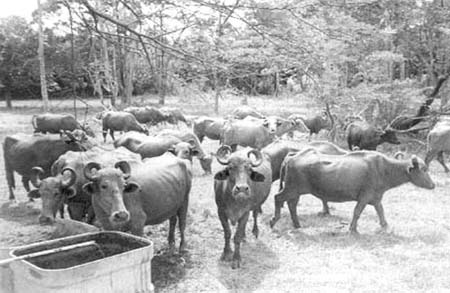
Figure 2. Brazilian Carabao buffaloes
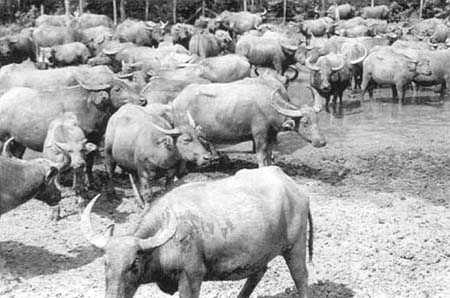
Another horse breed developed in these regions is the Puruca mini-horse (Figure 4), originating from crossbreeding between the Shetland pony breed, imported to the Marajo Island at the end of the 19th century, with other horse breeds, mainly the Marajoara. Today, it is an adapted horse breed, and very important to the work on the farms of the region (Dias, snt; Teixeira, 1985).
Animal Germplasm Bank of East Amazon - BAGAM
BAGAM is the Animal Germplasm Bank for the conservation of animal genetic resources of Embrapa East Amazon, and is a part of a research project entitled “Animal Genetic Resources of East Amazon”. The project is formed by two sub-projects: “Germplasm bank of animals of interest to the East region of the Brazilian Amazon” and “Genetic characterisation of buffaloes in the Brazilian Amazon, through the use of molecular markers”. These two sub-projects are linked to the research programme led by CENARGEN, called Conservation and Utilisation of Animal Genetic Resources.
BAGAM was implemented in the Experimental Farm “Ermerson Salimos - CEMES”, at Embrapa East Amazon, and is located at longitude 48º 30’ 54” W and at latitude 00º 45’ 21’ S, in the Marajo Island, at the right margin of the Paracauari river, in the Salvaterra county, state of Pará, Brazil. The climate at this experimental farm (Figure 5) is considered of the Ami (Koppen) type. The annual average temperature is 27ºC and the annual average rainfall is 2 943 mm.
The main objective of BAGAM is the conservation of germplasm of animals of economic and biological interest, threatened by extinction. Presently, BAGAM shelters two buffalo genetic groups: the Carabao breed and the Baio type, managed "on-farm". In the future, the two mentioned breeds of horses (Marajoara and Puruca) will be included in BAGAM, bearing in mind that both are exposed to a severe extinction process.
Figure 3. Marajoara horses
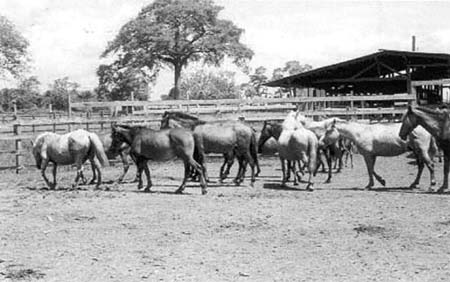
Figure 4. Puruca mini-horses
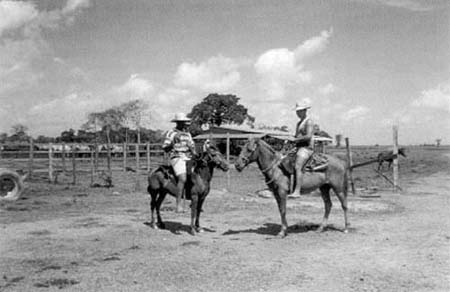
Figure 5. View of the Animal Germplasm Bank of East Amazon - BAGAM
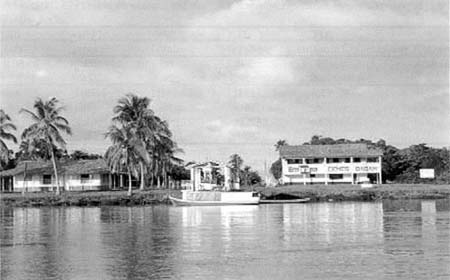
Results of the Conservation Work Accomplished at BAGAM
The results refer to data collected from 1996 to 2000, of the two genetic groups conserved at BAGAM, the buffaloes of the Baio type and of the Carabao breed (Marques, 2001).
Initially, both herds presented a critical number of animals, mainly females. The Baio type possessed a total herd of 67 animals, of which 33 are females. Today there are 113 animals of which 67 are females There was, therefore, a growth of 103 percent in the number of females. The Carabao breed presented a similar situation, with a total of 93 animals and only 35 females. Today, the Carabao herd has 123 animals, 63 being females (an increase of 80 percent). During this period, several culling processes had to be made, and this included females. The culling was necessary not only to adjust the size of the herds to the available areas but also to eliminate animals with reproduction problems.
Table 1. Reproductive performance of Carabao buffaloes in the Amazon Region (1996-2002).
|
Breeds/Crosses |
AFC |
CI |
SP |
PUL |
BE |
|
Carabao |
37 |
396 |
86 |
09 |
89.0 |
|
±2.9 |
±29.3 |
+29.3 |
±3.8 |
|
|
|
(16) |
(54) |
(54) |
(38) |
|
|
|
1/2 Carabao* |
36 |
395 |
85 |
7 |
|
|
±3.6 |
|
|
|
- |
|
|
(41) |
(1) |
(1) |
(4) |
|
AFC - Age at First Calving; CI - Calving Interval; SP - Service Period; PUL - Productive Useful Life; BE - Breeding efficiency; () - Observations. Number; * - Crosses other buffalo breeds.
Table 2. Reproductive performance of Baio Type buffaloes in the Amazon Region (1996-2000).
|
Breeds/Crosses |
AFC |
CI |
SP |
PUL |
BE |
|
Baio |
35±1.6 |
385±26.9 |
75±26.9 |
0.9±3.0 |
91.0 |
|
(9) |
(48) |
(48) |
(14) |
|
|
|
1/2 Baio |
36+1.2 |
389±28.7 |
79±.28.7 |
|
|
|
(2) |
(31) |
(31) |
- |
- |
AFC - Age at First Calving; CI - Calving Interval; SP - Service Period; PUL - Productive Useful Life; BE - Breeding efficiency.
The reproductive performance for Carabao and Baio type buffaloes is shown in Tables 1 and 2, respectively. The average birth rate for the studied period was 68 percent for the Carabao breed, and there has been a concentration of 68 percent of the calving at the less rainy season (July-December). The average sex ratio was 1.28:1, or 56.2 percent of males versus 43.8 of females.
For this same period, the average birth rate for the Baio was 74 percent, where there was a concentration of 80.47 percent of the calving at the less rainy season (July-December). The average secondary sex ratio was 1.37:1 or 57.75 percent of males versus 42.25 percent of females.
Weights at different ages for both herds are presented in Tables 3 and 4. As expected, the Carabao buffaloes were heavier than the Baio type, at all ages.
To compare body size of the two breeds, the most important body measurements of adult females were collected. The Carabao females showed the following measurements: height at front, 132 cm; height at back side, 130 cm; body length, 158 cm; croup length, 38.33 cm; croup width, 24 cm; thoracic perimeter, 207 cm. These were the measurements for the Baio type females: 136 cm; 130 cm; 163 cm; 36.27 cm; 28.09 cm; 208 cm, respectively.
Table 3. Weights (kg) at different ages of Carabao buffaloes breed raised in the Amazon Region (1996-2000).
| Sex |
Age |
||||
|
Birth weight |
Weaning |
18 months |
24 months |
Adult weight |
|
|
Females |
31±2.4 |
190±36.1 |
221±42.2 |
272±58.4 |
428±58.3 |
|
(8) |
(21) |
(22) |
(32) |
(61) |
|
|
Males |
31±3.6 |
185±38.9 |
223±52.0 |
273 ± 55.4 |
674 |
|
(6) |
(31) |
(37) |
(33) |
(2) |
|
() Observations. Number.
Table 4. Weights (kg) at different ages of Baio Type buffaloes raised in the Amazon Region (1996 2000).
| Sex |
Age |
||||
|
Birth weight |
Weaning |
18 months |
24 months |
Adult weight |
|
|
Females |
27±5.0 |
168±49.4 |
206±45.9 |
241±46.1 |
495±88.2 |
|
(39) |
(36) |
(46) |
(46) |
(19) |
|
|
Males |
28±5.2 |
184±50.5 |
195±56.1 |
224±58.1 |
555±0.0 |
|
(25) |
(20) |
(30) |
(16) |
(1) |
|
() Observations. Number.
Table 5. Scrotal Circumference (cm) of Carabao buffaloes breed raised in the Amazon Region (1996-2000).
| Breed |
Age |
|||
|
Weaning |
18 months |
24 months |
Adult |
|
|
Carabao |
14.3 |
18.0 |
20.2 |
22.8 |
|
±1.7 |
±2.6 |
±2.1 |
±2.6 |
|
|
(51) |
(37) |
(33) |
(27) |
|
() Observations. Number.
The morphological description of the Carabao females can be summarised as heavy head with a straight line profile; large open lira shape horns; coat colour from roan to a darker colour; medium and thick neck; medium size body; medium and strong arms and legs; and small udder and teats. The morphological description of the Baio type females is: soft head with a profile varying from a straight line to lightly concave; coat colour varying from a light tonality to a reddish one; short to medium neck; body size and croup width ranging from medium to large; medium and strong arms and legs; udder well inserted, varying from medium to large, presenting medium size teats.
Table 6. Scrotal circumference (cm) in Baio type raised in the Amazon Region (1996-2000).
| Breed |
Age |
|||
|
Weaning (cm) |
18 months (cm) |
24 months (cm) |
Adult (cm) |
|
|
Baio type |
16.2±1.6 |
18.8±2.6 |
20.8±3.3 |
23.8±3.4 |
|
(32) |
(35) |
(15) |
(08) |
|
() Observations. Number.
Data on scrotal circumference at different ages, are presented in Tables 5 and 6 for Carabao and Baio type buffaloes, respectively. The scrotums were measured from weaning until maturity. Adult Carabao and Baio type buffaloes showed an average scrotum circumference of 23.5 and 28 cm, respectively.
Final Considerations and Recommendations
The immensity of the Amazon shelters the largest biodiversity of the planet. Efforts should be made to coordinate conservation activities, such as the participation of local society, government institutions and NGOs, in view of the little investment and lack of initiatives to gather information and act on the preservation of the natural environment. Therefore, the following is recommended:
1. Description of the current situation of animal genetic resources in the region by identifying the threatened populations.
2. Characterisation of the animal genetic resources found in the region, at all levels, from morphological traits to molecular markers.
3. Conducting a thorough genetic conservation programme, taking into account the management and the sustained use of those animal genetic resources.
4. Creation of biological reservations, focusing on the conservation of the animals of the Amazon region.
5. Invigoration of the existing works and establishment of other animal gene banks in the Amazon region by stimulating investments from the private initiative.
References
Atlas do Meio Ambiente do Brasil. 1996. Empresa Brasileira de Pesquisa Agropecuária - 2 ed., ver. aum. - Brasília: EMBRAPA-SPI: Terra viva, pp. 160, ilust.
Destaque Amazônia. 1997. Anfíbios: uma fauna por estudar. Informativo editado pelo Museu Paraense Emílio Goeldi/CNPq - Ano X - nos 1 e 2 - Jan/ Abr., 5-13.
Dias, C. snt. Condicionamentos Históricos e Ecológicos; Estatuto, Regulamento do Registro Genealógico do Padrão Racial; Tabela de Pontos da ABCCRM. (Associação Rural Pecuária do Pará), pp. 25.
Falesi, I.C. & Silva, B.N.R. da. 1999. Ecossistema de várzeas da região do Baixo Amazonas. Belém: Embrapa Amazônia Oriental, pp. 75.
Marques, J.R.F. 2000. Conservation of genetic resources and the small animal populations of Amazon. In: Global conference on conservation of domestic animal genetic resources, 5., 2000, Brasília. Proceedings, Brasília: CENARGEN, CD-ROM. Conference, pal - 107 (Embrapa Genetic Resources and Biotechnology. Doc. 49). CDD 591.15, pp. 8
Teixeira, J.C.O. 1985. O Cavalo, Origem e Evolução. Cavalo Marajoara, v.11, pp. 8.
|
[4] Embrapa Amazônia
Oriental - BAGAM/LABGEN, Trav. Dr. Enéas Pinheiro, S/N, Marco,
66.095-100, Belém, Pará, Brazil [5] Embrapa Amazônia Oriental - BAGAM/LABGEN, Trav. Dr. Enéas Pinheiro, S/N, Marco, 66.095-100, Belém, Pará, Brazil [6] Embrapa Recursos Genéticos e Biotecnologia, CENARGEN, Brasília - DF, Brazil [7] Embrapa Recursos Genéticos e Biotecnologia, CENARGEN, Brasília - DF, Brazil |